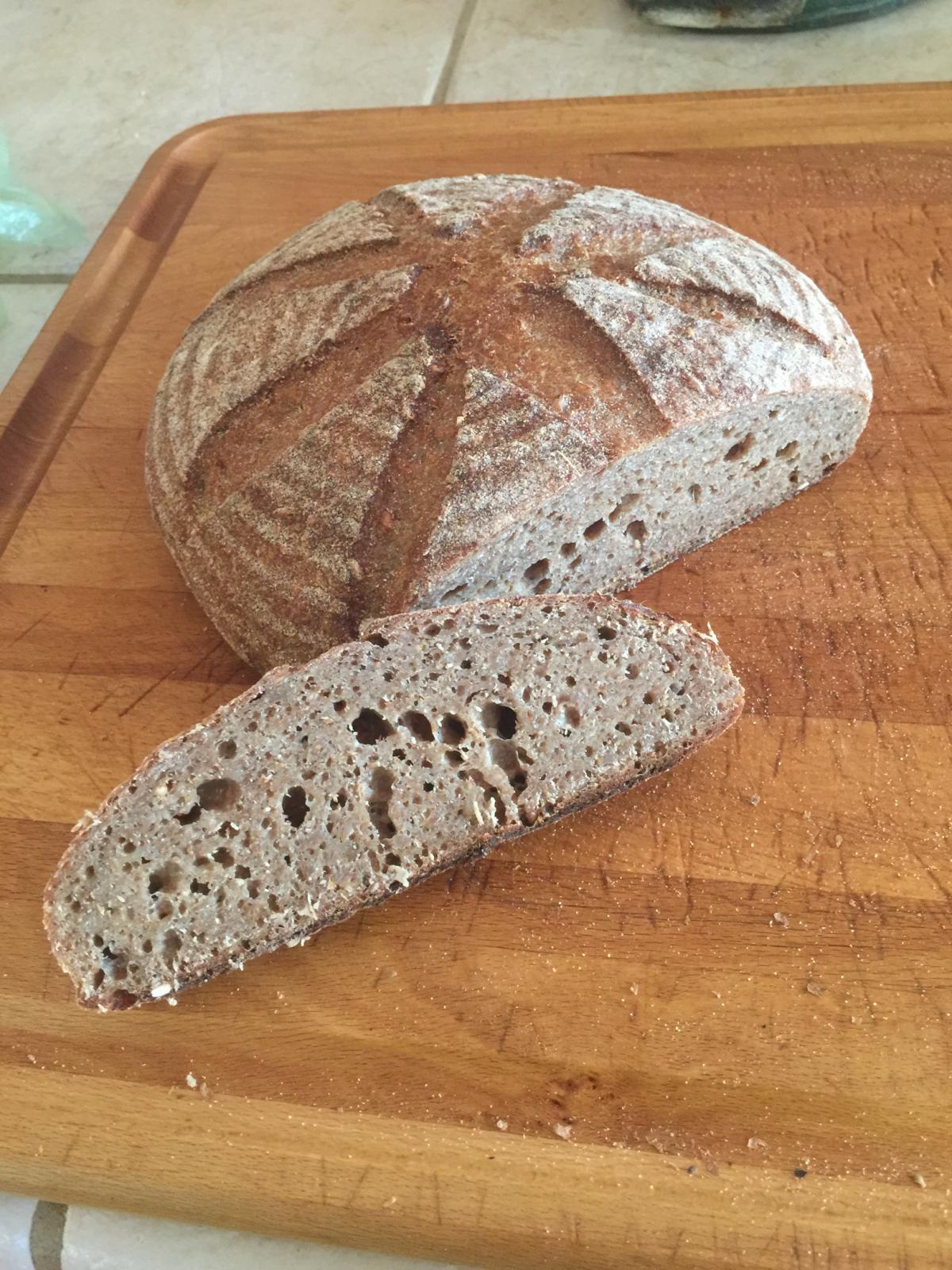
Delicious but still a bit gummy

A few days ago I decided to try the Pane Integrale from the Della Fattoria Bread book. The formula is:
Whole wheat flour 60%, bread flour 20%, pumpernickel flour 10%, cracked wheat 10%, water 84%, firm starter 14%, salt 3.3%, honey 7%.
I made a few modifications: not having pumpernickel flour I substituted dark rye flour; for the same reason I substituted cracked rye for the cracked wheat; and instead of cooking this all in one day I retarded the bulk fermentation overnight.
The first time I made this it was a mitigated disaster, clearly overproofed (elliptical), a number of huge holes in the crumb, and very gummy. I had inadvertently followed the wrong instructions for the firm starter and ended up with a starter at about 100% hydration. More serious (I think) was allowing the dough to proof too long and then taking it out of the oven when its temperature was 209F. But I say it was a mitigated disaster because once toasted it was delicious. So I tried again.
The second time turned out quite well and was even more delicious (see photo). It didn't rise quite as much as the one shown in the cookbook, but then it has twice as much rye. I did have a small problem with the starter - I had built it in the morning and by the next morning it was ready to be used, but I wasn't ready to bake, so I shoved it in the fridge until i got back from work. That evening it looked a bit past its prime but when I gave it the float test it did float (more of a neutral buoyancy though than the pop to the top I had had with the previous bake), so I went ahead and used it. This may also have contributed to not quite as much rise. So, all was (pretty much) well, except that the crumb is still a bit gummy, not to the extent of my first loaf, but still more than I would like. This time I did bake it to 211F, but that wasn't enough to dry out the crumb.
So, my question is, what to do about this slightly gummy crumb? I have had a few thoughts which I would like to run by the members.
First, should I bake this to a higher temperature? Or bake it longer at a lower temperature? I cooked it in a combo cooker for 20 mins at 450F then removed the lid and cooked it for about another 20 mins. I had convection on. With convection would 425F have done a better job of releasing the moisture from the crumb?
Second, is this the dreaded starch attack? I would think not given that this is leavened exclusively with sourdough. But perhaps when I increased the rye from 10% to 20% I should have increased the amount of starter/levain? Or might the somewhat weakened starter have played a role?
I would appreciate reactions to these thoughts as well as any other suggestions. Many thanks in advance.
Mark
P.S. The 3.3% salt is too salty for my taste - I will reduce it next time (to 2%).


I don't think the rye played a big role here. The very ripe starter took care of any rye problems.
The important ingredient is the whole wheat. How did you handle the dough from mixing to baking. Did you incorporate any folding into this high hydration dough? If so, when and more details please.
Tip: When the starter is peaking, and there's a need to delay the dough mixing, take some of the dough flour and thicken up the measured starter before putting it into the fridge. That will invigorate the yeast in the starter until you are ready hours later.
difficult to work with.
Weber's instructions to the letter, except for retarding the bulk fermentation: mixed for 2 mins in the mixer on low; let it rest for 20 mins; added salt and mixed with the dough hook for 6 mins, with the honey added after 5 mins; then bulk fermentation with 3 sets of stretch and folds every 30 mins after which I put it in the fridge. The next morning I let it warm up for probably 45 mins, preshaped it, let it rest for 10 mins, shaped and put it in the banneton, proofed it for a little more than an hour, then scored it and popped it into the combo cooker.
with folds... Did you see any changes in the dough, was it rising any before you retarded it?
Did the dough rise in the banneton?
but then this is 80% whole grain. The same goes for the proofing in the banneton. With the folds the dough became progressively more cohesive, as it should.
along with some yeast paste would have helped it, added after the 45 min warm up or even after seeing it weakly rise in the banneton. The extra kneading wouldn't have hurt it any.
... of the photo. If you look closely you can see tiny globules of white, and on the bottom of the loaf a thin layer of white on top of the crust. Some of my breads turn out that way, and I cannot figure out why or find any information about this whiteness! When you bite it, the crumb turns a little white and clumps a little, even though the texture is fine. What is the cause of this? Why does one sourdough bread I make have this whiteness problem and another one doesn't?
P.S. I'll be retrieving a photo once my bread from last night thaws.
I suspect this is raw flour that was incorporated into the dough during shaping. Not a desirable feature.
David